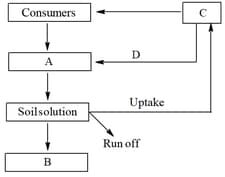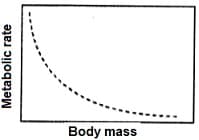MEDIUM
Earn 100
Assertion : Excess of sulphur reaches to reservoir pool.
Reason : Thiobacillus and Desulfovibrio convert elemental sulphur into the sulphate.
(a)If both the assertion and the reason are true, and the reason is a correct explanation of the assertion
(b)If both the assertion and reason are true, but the reason is not a correct explanation of the assertion
(c)If the assertion is true but the reason is false
(d)If both the assertion and reason are false
(e)If the assertion is false but reason is true
50% studentsanswered this correctly
Important Questions on Construct and revise an explanation based on evidence for the cycling of matter and flow of energy in aerobic and anaerobic conditions.
HARD
Life Sciences>Ecosystems: Interactions, Energy, and Dynamics>Construct and revise an explanation based on evidence for the cycling of matter and flow of energy in aerobic and anaerobic conditions.>Cycles of Matter and Energy Transfer in Ecosystems - Photosynthesis and cellular respiration (including anaerobic processes) provide most of the energy for life processes
HARD
Life Sciences>Ecosystems: Interactions, Energy, and Dynamics>Construct and revise an explanation based on evidence for the cycling of matter and flow of energy in aerobic and anaerobic conditions.>Cycles of Matter and Energy Transfer in Ecosystems - Photosynthesis and cellular respiration (including anaerobic processes) provide most of the energy for life processes
MEDIUM
Life Sciences>Ecosystems: Interactions, Energy, and Dynamics>Construct and revise an explanation based on evidence for the cycling of matter and flow of energy in aerobic and anaerobic conditions.>Cycles of Matter and Energy Transfer in Ecosystems - Photosynthesis and cellular respiration (including anaerobic processes) provide most of the energy for life processes
EASY
Life Sciences>Ecosystems: Interactions, Energy, and Dynamics>Construct and revise an explanation based on evidence for the cycling of matter and flow of energy in aerobic and anaerobic conditions.>Cycles of Matter and Energy Transfer in Ecosystems - Photosynthesis and cellular respiration (including anaerobic processes) provide most of the energy for life processes
Given below is a simplified model of phosphorus cycling in a terrestrial ecosystem with four blanks (A-D). Identify the blanks.

MEDIUM
Life Sciences>Ecosystems: Interactions, Energy, and Dynamics>Construct and revise an explanation based on evidence for the cycling of matter and flow of energy in aerobic and anaerobic conditions.>Cycles of Matter and Energy Transfer in Ecosystems - Photosynthesis and cellular respiration (including anaerobic processes) provide most of the energy for life processes
MEDIUM
Life Sciences>Ecosystems: Interactions, Energy, and Dynamics>Construct and revise an explanation based on evidence for the cycling of matter and flow of energy in aerobic and anaerobic conditions.>Cycles of Matter and Energy Transfer in Ecosystems - Photosynthesis and cellular respiration (including anaerobic processes) provide most of the energy for life processes
EASY
Life Sciences>Ecosystems: Interactions, Energy, and Dynamics>Construct and revise an explanation based on evidence for the cycling of matter and flow of energy in aerobic and anaerobic conditions.>Cycles of Matter and Energy Transfer in Ecosystems - Photosynthesis and cellular respiration (including anaerobic processes) provide most of the energy for life processes
EASY
Life Sciences>Ecosystems: Interactions, Energy, and Dynamics>Construct and revise an explanation based on evidence for the cycling of matter and flow of energy in aerobic and anaerobic conditions.>Cycles of Matter and Energy Transfer in Ecosystems - Photosynthesis and cellular respiration (including anaerobic processes) provide most of the energy for life processes
EASY
Life Sciences>Ecosystems: Interactions, Energy, and Dynamics>Construct and revise an explanation based on evidence for the cycling of matter and flow of energy in aerobic and anaerobic conditions.>Cycles of Matter and Energy Transfer in Ecosystems - Photosynthesis and cellular respiration (including anaerobic processes) provide most of the energy for life processes
EASY
Life Sciences>Ecosystems: Interactions, Energy, and Dynamics>Construct and revise an explanation based on evidence for the cycling of matter and flow of energy in aerobic and anaerobic conditions.>Cycles of Matter and Energy Transfer in Ecosystems - Photosynthesis and cellular respiration (including anaerobic processes) provide most of the energy for life processes
MEDIUM
Life Sciences>Ecosystems: Interactions, Energy, and Dynamics>Construct and revise an explanation based on evidence for the cycling of matter and flow of energy in aerobic and anaerobic conditions.>Cycles of Matter and Energy Transfer in Ecosystems - Photosynthesis and cellular respiration (including anaerobic processes) provide most of the energy for life processes
EASY
Life Sciences>Ecosystems: Interactions, Energy, and Dynamics>Construct and revise an explanation based on evidence for the cycling of matter and flow of energy in aerobic and anaerobic conditions.>Cycles of Matter and Energy Transfer in Ecosystems - Photosynthesis and cellular respiration (including anaerobic processes) provide most of the energy for life processes
Which one of the following element never goes to the atmosphere?
HARD
Life Sciences>Ecosystems: Interactions, Energy, and Dynamics>Construct and revise an explanation based on evidence for the cycling of matter and flow of energy in aerobic and anaerobic conditions.>Cycles of Matter and Energy Transfer in Ecosystems - Photosynthesis and cellular respiration (including anaerobic processes) provide most of the energy for life processes

MEDIUM
Life Sciences>Ecosystems: Interactions, Energy, and Dynamics>Construct and revise an explanation based on evidence for the cycling of matter and flow of energy in aerobic and anaerobic conditions.>Cycles of Matter and Energy Transfer in Ecosystems - Photosynthesis and cellular respiration (including anaerobic processes) provide most of the energy for life processes
EASY
Life Sciences>Ecosystems: Interactions, Energy, and Dynamics>Construct and revise an explanation based on evidence for the cycling of matter and flow of energy in aerobic and anaerobic conditions.>Cycles of Matter and Energy Transfer in Ecosystems - Photosynthesis and cellular respiration (including anaerobic processes) provide most of the energy for life processes
plant mice snake peacock
MEDIUM
Life Sciences>Ecosystems: Interactions, Energy, and Dynamics>Construct and revise an explanation based on evidence for the cycling of matter and flow of energy in aerobic and anaerobic conditions.>Cycles of Matter and Energy Transfer in Ecosystems - Photosynthesis and cellular respiration (including anaerobic processes) provide most of the energy for life processes
EASY
Life Sciences>Ecosystems: Interactions, Energy, and Dynamics>Construct and revise an explanation based on evidence for the cycling of matter and flow of energy in aerobic and anaerobic conditions.>Cycles of Matter and Energy Transfer in Ecosystems - Photosynthesis and cellular respiration (including anaerobic processes) provide most of the energy for life processes
Match the trophic levels with their correct species examples in grassland ecosystem.
| (a) | Fourth trophic level | (i) | Crow |
| (b) | Second trophic level | (ii) | Vulture |
| (c) | First trophic level | (iii) | Rabbit |
| (d) | Third trophic level | (iv) | Grass |
Select the correct option.
EASY
Life Sciences>Ecosystems: Interactions, Energy, and Dynamics>Construct and revise an explanation based on evidence for the cycling of matter and flow of energy in aerobic and anaerobic conditions.>Cycles of Matter and Energy Transfer in Ecosystems - Photosynthesis and cellular respiration (including anaerobic processes) provide most of the energy for life processes
MEDIUM
Life Sciences>Ecosystems: Interactions, Energy, and Dynamics>Construct and revise an explanation based on evidence for the cycling of matter and flow of energy in aerobic and anaerobic conditions.>Cycles of Matter and Energy Transfer in Ecosystems - Photosynthesis and cellular respiration (including anaerobic processes) provide most of the energy for life processes
MEDIUM
Life Sciences>Ecosystems: Interactions, Energy, and Dynamics>Construct and revise an explanation based on evidence for the cycling of matter and flow of energy in aerobic and anaerobic conditions.>Cycles of Matter and Energy Transfer in Ecosystems - Photosynthesis and cellular respiration (including anaerobic processes) provide most of the energy for life processes

